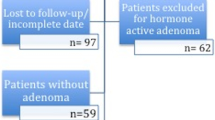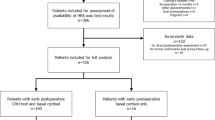Abstract
The ability to reliably identify patients with new hypocortisolemia acutely following pituitary surgery is critical. We aimed to quantify the postoperative cortisol stress response following selective transsphenoidal adenomectomy, as a marker for postoperative preservation of functional pituitary gland. Records of 208 patients undergoing transsphenoidal operations for pituitary lesions were reviewed. Patients with Cushing’s Disease, preoperative adrenal insufficiency, and those receiving intraoperative steroids were excluded. To quantify the postoperative stress response, the ∆ cortisol index was defined as the postoperative day (POD) 1 morning cortisol minus the preoperative morning cortisol level. The incidence of new hypocortisolemia requiring glucocorticoid replacement upon hospital discharge was also recorded. Fifty-two patients met inclusion criteria. The mean preoperative, POD1, and POD2 cortisol levels were 16.5, 29.2, and 21.8 μg/dL, respectively. Morning fasting cortisol levels on POD1 ranged from 4.2 to 73.0 μg/dL. The ∆ cortisol index ranged from −19.0 to +56.2 (mean +12.7 μg/dL). Five patients (9.6 %) developed new hypocortisolemia on POD 1-3 requiring glucocorticoid replacement; only one required long-term replacement. The mean ∆ cortisol in patients requiring postoperative glucocorticoids was −2.8 μg/dL, compared with +14.4 μg/dL in patients without evidence of adrenal insufficiency (p = 0.005). Of the 32 patients (61.5 %) with a ∆cortisol >25 μg/dL, none developed postoperative adrenal insufficiency. The postoperative cortisol stress response, as quantified by the ∆ cortisol index, holds potential as a novel and complimentary screening method to predict preservation of normal pituitary function and acute development of new ACTH deficiency following transsphenoidal pituitary surgery.


Similar content being viewed by others
References
Hout WM, Arafah BM, Salazar R, Selman W (1988) Evaluation of the hypothalamic-pituitary-adrenal axis immediately after pituitary adenomectomy: is perioperative steroid therapy necessary? J Clin Endocrinol Metab 66(6):1208–1212
Zada G, Kelly DF, Cohan P, Wang C, Swerdloff R (2003) Endonasal transsphenoidal approach for pituitary adenomas and other sellar lesions: an assessment of efficacy, safety, and patient impressions. J Neurosurg 98(2):350–358
Arafah BM, Kailani SH, Nekl KE, Gold RS, Selman WR (1994) Immediate recovery of pituitary function after transsphenoidal resection of pituitary macroadenomas. J Clin Endocrinol Metab 79(2):348–354
Watts NB, Tindall GT (1988) Rapid assessment of corticotropin reserve after pituitary surgery. JAMA 259(5):708–711
Nomikos P, Ladar C, Fahlbusch R, Buchfelder M (2004) Impact of primary surgery on pituitary function in patients with non-functioning pituitary adenomas: a study on 721 patients. Acta Neurochir (Wien) 146(1):27–35
Marko NF, Gonugunta VA, Hamrahian AH, Usmani A, Mayberg MR, Weil RJ (2009) Use of morning serum cortisol level after transsphenoidal resection of pituitary adenoma to predict the need for long-term glucocorticoid supplementation. J Neurosurg 111(3):540–544
Arafah BM (2006) Hypothalamic pituitary adrenal function during critical illness: limitations of current assessment methods. J Clin Endocrinol Metab 91(10):3725–3745
Auchus RJ, Shewbridge RK, Shepherd MD (1997) Which patients benefit from provocative adrenal testing after transsphenoidal pituitary surgery? Clin Endocrinol (Oxf) 46(1):21–27
Inder WJ, Hunt PJ (2002) Glucocorticoid replacement in pituitary surgery: guidelines for perioperative assessment and management. J Clin Endocrinol Metab 87(6):2745–2750
Salem M, Tainsh RE Jr, Bromberg J, Loriaux DL, Chernow B (1994) Perioperative glucocorticoid coverage. A reassessment 42 years after emergence of a problem. Ann Surg 219(4):416–425
Garcia-Luna PP, Leal-Cerro A, Rocha JL, Trujillo F, Garcia-Pesquera F, Astorga R (1990) Evaluation of the pituitary-adrenal axis before, during and after pituitary adenomectomy. Is perioperative glucocorticoid therapy necessary? Acta Endocrinol (Copenh) 122(1):83–88
Ortega AE, Peters JH, Incarbone R, Estrada L, Ehsan A, Kwan Y, Spencer CJ, Moore-Jeffries E, Kuchta K, Nicoloff JT (1996) A prospective randomized comparison of the metabolic and stress hormonal responses of laparoscopic and open cholecystectomy. J Am Coll Surg 183(3):249–256
Squirrell DM, Majeed AW, Troy G, Peacock JE, Nicholl JP, Johnson AG (1998) A randomized, prospective, blinded comparison of postoperative pain, metabolic response, and perceived health after laparoscopic and small incision cholecystectomy. Surgery 123(5):485–495
Karayiannakis AJ, Makri GG, Mantzioka A, Karousos D, Karatzas G (1997) Systemic stress response after laparoscopic or open cholecystectomy: a randomized trial. Br J Surg 84(4):467–471
Glaser F, Sannwald GA, Buhr HJ, Kuntz C, Mayer H, Klee F, Herfarth C (1995) General stress response to conventional and laparoscopic cholecystectomy. Ann Surg 221(4):372–380
Hoda MR, El-Achkar H, Schmitz E, Scheffold T, Vetter HO, De Simone R (2006) Systemic stress hormone response in patients undergoing open heart surgery with or without cardiopulmonary bypass. Ann Thorac Surg 82(6):2179–2186
Hagg E, Asplund K, Lithner F (1987) Value of basal plasma cortisol assays in the assessment of pituitary-adrenal insufficiency. Clin Endocrinol (Oxf) 26(2):221–226
Stewart PM, Corrie J, Seckl JR, Edwards CR, Padfield PL (1988) A rational approach for assessing the hypothalamo-pituitary-adrenal axis. Lancet 1(8596):1208–1210
Jayasena CN, Gadhvi KA, Gohel B, Martin NM, Mendoza N, Meeran K, Dhillo WS (2009) Day 5 morning serum cortisol predicts hypothalamic-pituitary-adrenal function after transsphenoidal surgery for pituitary tumors. Clin Chem 55(5):972–977
Mukherjee JJ, de Castro JJ, Kaltsas G, Afshar F, Grossman AB, Wass JA, Besser GM (1997) A comparison of the insulin tolerance/glucagon test with the short ACTH stimulation test in the assessment of the hypothalamo-pituitary-adrenal axis in the early post-operative period after hypophysectomy. Clin Endocrinol (Oxf) 47(1):51–60
Widmer IE, Puder JJ, Konig C, Pargger H, Zerkowski HR, Girard J, Muller B (2005) Cortisol response in relation to the severity of stress and illness. J Clin Endocrinol Metab 90(8):4579–4586
Conflict of interest
The authors have no financial relationships or conflicts of interest to disclose.
Author information
Authors and Affiliations
Corresponding author
Rights and permissions
About this article
Cite this article
Zada, G., Tirosh, A., Huang, A.P. et al. The postoperative cortisol stress response following transsphenoidal pituitary surgery: a potential screening method for assessing preserved pituitary function. Pituitary 16, 319–325 (2013). https://doi.org/10.1007/s11102-012-0423-7
Published:
Issue Date:
DOI: https://doi.org/10.1007/s11102-012-0423-7




